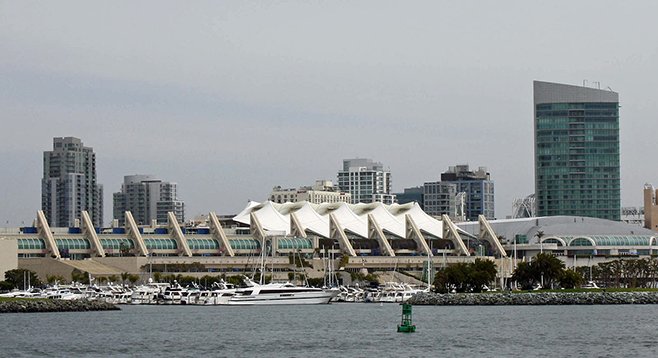 Facebook
Facebook
 X
X
 Instagram
Instagram
 TikTok
TikTok
 Youtube
Youtube

Since the convention-center expansion was thumbed down by the appellate court, the corporate-welfare crowd — particularly the Chargers and U-T San Diego — has switched to touting a combined football stadium/convention center.
"It's going from the questionable [the expansion] to the ridiculous [the combined stadium/convention center]," says the nation's top authority on convention centers, professor Heywood Sanders, who wrote a seminal piece on convention center overexpansion for the Brookings Institution, and recently wrote the book Convention Center Follies, which tells how the nation has become so glutted with convention-center space that some centers are paying conventions to come to their cities while others are slashing prices steeply.
There are combined convention centers/stadiums in Atlanta, Indianapolis, and St. Louis. None does well as a center, says Sanders.
"The bottom line is there are 100,000 to 150,000 square feet of flat space on the floor." San Diego's center now has more than 600,000 square feet. Plus, the Chargers stadium/convention center would be several blocks away, and over the railroad tracks. Studies show that convention attendees don't want to walk from one building to another — even across the street. That's why, when the establishment was pushing the expansion, the key words were "contiguous, contiguous, contiguous." (Watch for "contiguous" to disappear from the local vocabulary.)
"Nothing I have ever seen suggests meeting planners are rushing to have conventions on playing fields of domed stadiums," says Sanders.
A facility with little space could not be an expansion of the current facility. It would have to be a stand-alone facility for small conventions. But there is no need for that. With all the competition and price-slashing in the overbuilt industry, San Diego won't have a shortage of space. Comic-Con is San Diego's big enchilada: will costumed attendees be content to be split between the main center and a smaller one a hike away?
The Chargers claim they are thinking about having space below the playing field. It's doubtful that will be taken seriously.
One thing is certain: mainstream media will pump the combined facility without examining the impracticalities, including the experience elsewhere.
And the convention center? It has a habit of exaggerating the statistics it uses, as Sanders has pointed out in the Reader many times. Yesterday (Aug. 10), he sent along another:
The local center predicted that the May 2014 gathering of the American Thoracic Society would have 16,000 attendees. But, last year, there were 13,596 in Philadelphia; in 2012, there were 14,661 in San Francisco; in 2011, there were 12,817 in Denver. This year's actual number in San Diego was 14,386.


Since the convention-center expansion was thumbed down by the appellate court, the corporate-welfare crowd — particularly the Chargers and U-T San Diego — has switched to touting a combined football stadium/convention center.
"It's going from the questionable [the expansion] to the ridiculous [the combined stadium/convention center]," says the nation's top authority on convention centers, professor Heywood Sanders, who wrote a seminal piece on convention center overexpansion for the Brookings Institution, and recently wrote the book Convention Center Follies, which tells how the nation has become so glutted with convention-center space that some centers are paying conventions to come to their cities while others are slashing prices steeply.
There are combined convention centers/stadiums in Atlanta, Indianapolis, and St. Louis. None does well as a center, says Sanders.
"The bottom line is there are 100,000 to 150,000 square feet of flat space on the floor." San Diego's center now has more than 600,000 square feet. Plus, the Chargers stadium/convention center would be several blocks away, and over the railroad tracks. Studies show that convention attendees don't want to walk from one building to another — even across the street. That's why, when the establishment was pushing the expansion, the key words were "contiguous, contiguous, contiguous." (Watch for "contiguous" to disappear from the local vocabulary.)
"Nothing I have ever seen suggests meeting planners are rushing to have conventions on playing fields of domed stadiums," says Sanders.
A facility with little space could not be an expansion of the current facility. It would have to be a stand-alone facility for small conventions. But there is no need for that. With all the competition and price-slashing in the overbuilt industry, San Diego won't have a shortage of space. Comic-Con is San Diego's big enchilada: will costumed attendees be content to be split between the main center and a smaller one a hike away?
The Chargers claim they are thinking about having space below the playing field. It's doubtful that will be taken seriously.
One thing is certain: mainstream media will pump the combined facility without examining the impracticalities, including the experience elsewhere.
And the convention center? It has a habit of exaggerating the statistics it uses, as Sanders has pointed out in the Reader many times. Yesterday (Aug. 10), he sent along another:
The local center predicted that the May 2014 gathering of the American Thoracic Society would have 16,000 attendees. But, last year, there were 13,596 in Philadelphia; in 2012, there were 14,661 in San Francisco; in 2011, there were 12,817 in Denver. This year's actual number in San Diego was 14,386.
Comments